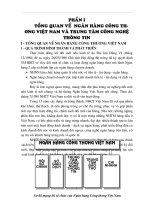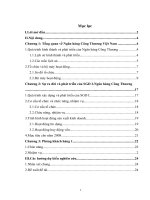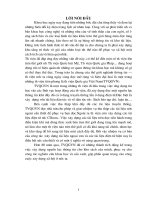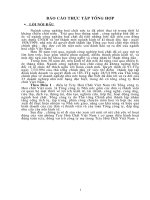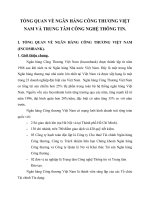VNPT 5g 2022, tổng quan mạng 5G triển khai tại VNPT việt nam
Bạn đang xem bản rút gọn của tài liệu. Xem và tải ngay bản đầy đủ của tài liệu tại đây (2.93 MB, 60 trang )
VNPT NET2 IoT and 5G
Workshop
Ha Nguyen H
2018-12-12
Agenda
▪ IoT
▪ Overview of IoT Architecture
▪ Ericsson Solution for IoT
▪ 5G
▪ 5G Architecture and Standardization
▪ Ericsson Solution for 5G
▪ Cloud Infrastructure & Automation
Agenda
▪ IoT
▪ Overview of IoT Architecture
▪ Ericsson Solution for IoT
▪ 5G
▪ 5G Architecture and Standardization
▪ Ericsson Solution for 5G
▪ Cloud Infrastructure & Automation
Cellular IoT market outlook
400 million
connections
$12 billion
in revenue
2016
New use
cases
1.8 billion
connections by 2023
>0.9 billion are Massive IoT connections
New
business
model
$200 billion
in revenue by 2025
Source: Ericsson and Analysys Mason
Massive IoT EPC Overview | Ericsson Internal | 27/221 09-FGB 101 256 Uen, Rev D | 2018-04-16
Cellular for Massive IoT
Meeting diversity of use case requirements
IoT on LTE
NB-IoT
IoT on GSM
CAT-M1
EC-GSM-IoT
Low-bitrate applications with
extreme coverage and low cost
devices
Wider range of applications
with low-medium bitrate,
mobility and voice support
GSM as fallback with improved
battery life or extended
coverage for the last mile
Massive IoT EPC Overview | Ericsson Internal | 27/221 09-FGB 101 256 Uen, Rev D | 2018-04-16
Massive IoT
Technology characteristics
Cat-M1
Peak
Throughput
Mobility
Voice
Bandwidth
Coverage
Battery life
1.4 MHz
160dB
(+15dB)
10+ Year
0.8/1 Mbps
(300/375 kbps)
Connected & idle
mode mobility
Supported
NB-IoT
200 kHz
164dB
(+20dB)
10+ Year
227/250 kbps
(21/63 kbps)
Idle mode
mobility
Not Supported
EC-GSM-IoT
200 kHz/
600 kHz
164dB
(+20dB)
10+ Year
473/473 kbps
(97/97 kbps)
Idle mode
mobility
Not Supported
Massive IoT EPC Overview | Ericsson Internal | 27/221 09-FGB 101 256 Uen, Rev D | 2018-04-16
Cellular IoT Module Cost
Evolution
CAT-4
CAT-1
CAT-M1
NB-IOT
Significantly reduced
device complexity,
functionality and
capability, thus cost
$25-$50
$13-$25
$7-$12
$5-$10
$2- $5
2017
2018
Massive IoT Architecture &
Approaches
What is NB-IoT ?
3GPP IOT
NB-IoT specific
DoNAS
Non-IP and IP
data paths
UP/RRC
resume T6a
Common IoT functions
PSM
eDRX
C-SGN/
IoT Server
NB Devices
Low Complexity
UE Paging
Extended
Coverage
Device trigger
over SGd
(3GPP 23.401)
CN selection mechanisms
Commercial in confidence | © Ericsson AB 2014 | 2015-12-14 | Page 9
IOT Core Architecture (3GPP TR 23.720)
Standalone function including:
• Ability for the external entities (partners) to
discover the exposed service capabilities
• Authentication and Authorization
T6a
(Diameter)
• Non-IP Data Delivery
• Policy enforcement towards AS
SCEF
• Attach procedure changes
• Data over NAS
• CN selection procedures
• UP/RRC Resume
• Charging
PtP IP tunnel for non-IP data
Cat-M1 &
Cat-NB
UE
S1-MME
S1-MME/-U
C-SGN
S1-MME (NAS (encrypted
DoNAS
Small Data))
• Data conversion
• CN selection
• MME, SGW and PGW
functions (23.401 etc)
IP Data
SGd or SGs over
MSC/SMS-IWF
SMSC/
IWMSC
CIoT =
C-SGN =
Massive IoT EPC Overview | Ericsson Internal | 27/221 09-FGB 101 256 Uen, Rev D | 2018-04-16
AS
SCEF =
Cellular Internet of Things
CIoT Serving Gateway Node, i.e. NB-IoT
Core (MME, SGW & EPG)
Service Capability Exposure Function
Ericsson Target Architecture – Massive IoT
EDA
PDN Type “Non-IP”
PDN Type “IPv4/IPv6”
SMS-SC
HSS
SGs
CUDB
S6t
S6a
UE
Control
Plane
eNB
MME
S1-MME
T6a
Cat-NB
"NB-IoT“
SGi PtP
tunnelling using
UDP/IP
(200 kHz)
Cat-M1
(1.4 MHz)
UE
User
Plane
S1-U
SCEF/
MTC-IWF
T8’ Extension
IoT-A
EPG
SGW functions
Massive IoT EPC Overview | Ericsson Internal | 27/221 09-FGB 101 256 Uen, Rev D | 2018-04-16
Commercial in confidence | © Ericsson AB 2018
T8
Local
operator
Apps &
ecosystem
EPG
PGW functions
SGi
Why a Service Capability Exposure Function?
Without SCEF
Limited control by operator on the traffic generated by and
towards M2M devices (threat of congestion!)
With SCEF
Control over the M2M traffic generated by partners/customers
(e.g. Authentication, Authorization, Throttling)
No communication between network and AS
Network informs SCEF about the location, reachability, status,
etc., SCEF informs AS
Complex communication and protocols
Easy to integrate for partners/customer applications by means of
RESTful interface, short TTM for application developers, no need
to understand network complexity. Add new RESTful interfaces.
Only single point-to-point connection between device and
application server
Possibility to connect devices to multiple application servers
No added value by operator apart from being a bitpipe
Offering additional functionality in order to become part of the
value chain (e.g. monitoring, high latency comm., ID/IMSI
mapping, grouping, etc.)
AS
M2M
Device
Mobile
Network
AS
M2M
Device
Mobile
Network
SCEF
AS
Ericsson Internal | 2018-02-21
Massive IoT Core
Main operator choices
Use case 1 & 2
Combined core
1.
Use case 3
IOT slice(s)
EPC Native HW
(combined MBB & IoT Core)
– SW upgrade to SGSN-MME 1 & EPG 1
– Build on installed Ericsson Core
– Start Massive IoT launch before EPC virtualization and
slicing
1.
2.
EPC or
vEPC
MBB/DMBB
3. vEPC IoT
(Existing
EPC)
2.
vEPC MBB VNS & DMBB VNS (combined
MBB & IoT Core)
– SW upgrade to SGSN-MME 1 & EPG 1
– Start Massive IoT launch before EPC slicing
3.
vEPC IoT VNS
(Separate Core for IoT)
– Optimization and scaling for fast IoT growth
– Separation of concerns
Massive IoT EPC Overview | Ericsson Internal | 27/221 09-FGB 101 256 Uen, Rev D | 2018-04-16
Network Slice Selection
Choice of mechanisms
Currently supported
APN / PLMN
CN #2: IoT
APN 1
APN 2
HSS
DECOR
NB-IoT
CN #1: MBB
APN 1
Roadmap
CN #2:
NB-IoT
CN #1: MBB
APN 2
MME
HSS
C-SGN
CN #2:
IoT
CN #1:
MBB
MME
eDECOR
HSS
5G Slicing
CN #2:
IoT
CN #1:
MBB
CN #1:
MBB
S-NSSAI #1
CN #2: IoT
S-NSSAI #2
C-SGN
UE Usage
Type 1 & 2
MME
HSS
IoT
Core
UDM
SMF1/UPF1
SMF/UPF3
SMF2/UPF2
AMF
3GPP Access
3GPP Access
Common LTE Access
Common LTE Access
— Separate APNs for — CN selection by RAN
isolating UP
using PLMN id
sessions
— Requires RAN and
— Requires CN
Core support
support
— Policy-controlled GW
— All device types
selection
supported
— RAN based CN selection by
using NB-IoT info
— CN selection using HSS info
(UE Usage Type)
— Simple - requires RAN
support only
— Requires CN and RAN
support
— Applicable to CAT-NB
— All device types supported
2018-10-23 | Cloud Packet Core Roadmap | Ericsson Confidential | Page 14
— CN selection by RAN:
Retrieving UE belonging from
network (at first attach in PLMN)
— Backward compatible with DECOR
— Requires UE, RAN, EPC and HSS
support
5G Access
— Slice selection based on UE info
(S-NSSAI)
— Requires UE, CN and RAN
support
— E2E slicing (RAN slice aware)
— Connectivity to multiple slices
simultaneously
CN Selection Options (3GPP)
PLMN Based
RAN based CN
selection
DECOR
eDECOR
Rel-8
Rel-13
Rel-13
Rel-14
Device support
need
Yes
No
No
Yes
RAN support need
Yes
Yes
Yes
Yes
Core support need
Yes
No
Yes
Yes
HSS support need
Yes
No
Yes
Yes
Devices applicable
All
Cat-NB
All
All
3GPP
Massive IoT EPC Overview | Ericsson Internal | 27/221 09-FGB 101 256 Uen, Rev D | 2018-04-16
Agenda
▪ IoT
▪ Overview of IoT Architecture
▪ Ericsson Solution for IoT
▪ 5G
▪ 5G Architecture and Standardization
▪ Ericsson Solution for 5G
▪ Cloud Infrastructure & Automation
5G Drivers and use cases
Massive MTC
Critical MTC
Enhanced MBB
Fixed Wireless Access
2018-07-30 | 5G Technology and Standardization | Ericsson Confidential | Page 17 (45)
New eMBB use cases are pushing connectivity limits
Source: Qualcomm
2018-08-02 | 5G Architecture Readiness WS4_TrueMove Master Plan | Ericsson Confidential |
5G UE-RAN-CN Connectivity options
Two architecture tracks in 3GPP Rel-15
5G EPC
3GPP released
Q4 17
S1-based
Option 1
N2/N3 (new interface)
Option 3
Option 5
Option 7
LTE
NR
LTE/EPC
3GPP released
Q2 18
5GC
Option 2
Option 4
NR
LTE
LTE/EPC
NR/EPC
LTE/EPC
NR/EPC
LTE/5GC
| PA1 | 2018-07-13 | 5G Core | Commercial in confidence | Page 19
NR/5GC
First 5G NR Specs approved
Mobile industry works together to delivercomplete 5G system standard on time
Dec 2017: Approval of the first set of specifications
for Non-Standalone (NSA) operation
| PA1 | 2018-07-13 | 5G Core | Commercial in confidence | Page 20
Jun 2018: Approval of specifications for
Standalone (SA) operation
NSA Architecture Sub-options
Option 3
3GPP TR 38.801
Option 3a
5G EPC
MME
Option 3x
5G EPC
5G EPC
SGW
MME
MME
SGW
SGW
S1-U
X2
LTE
X2
X2
NR
• S1-C always to eNB
• S1-U terminates on eNB
• LTE eNB decides if UP traffic is routed via NR
gNB and/or LTE eNB (split bearer terminated in
LTE eNB, a.k.a. Master Node)
LTE
NR
• S1-C always to LTE eNB
• LTE eNB decides if a bearer is routed
to LTE eNB or NR gNB (bearer switching in SGW)
LTE
NR
• S1-C always to LTE eNB
• S1-U terminates on NR gNB
• NR gNB decides if UP traffic is routed via NR
gNB and/or LTE eNB (split bearer terminated
in gNB, a.k.a. Secondary Node)
Option 3
Option 3a
Option 3x
Possible to split UL & DL
With split of UL & DL, risk of limited UL coverage
Possible to split UL & DL
Possible for radio resource utilization coordination
between LTE and NR within RAN
Not possible for RAN to coordinate radio resource
utilization across LTE and NR
Possible for radio resource utilization coordination
between LTE and NR within RAN
Major up-sizing of eNB processing needed to
handle both LTE and NR
Handling of multiple UP paths adds complexity and
signaling
Avoids pushing higher bandwidth 5G data through
LTE eNB
| PA1 | 2018-07-13 | 5G Core | Commercial in confidence | Page 21
Option 3x allows early 5G launch through reusing the LTE control plane and more efficient use of LTE and NR resources
Seamless Evolution to 5G
5G EPC
EPC
SW Upgrade
Option 3
Option 1
Option 1
LTE
LTE
LTE
LTE
NR
1
1
5G EPC + 5GC
SW Upgrade
with new functions
(Dual mode core)
Option 1
Option 3
LTE
LTE/NR
Option 2
NR
1
3
3
2
—
—
Introduce NR air interface to offer peak data rates early
Leverage VoLTE for voice while NR matures
—
—
Introduce NGC and NG services without disturbing
existing deployment
Leverage VoLTE for voice while NR matures
No impact to legacy services and in-market devices (incl. early 5G devices) while the network evolves
| PA1 | 2018-07-13 | 5G Core | Commercial in confidence | Page 22
5G EPC
5G EPC functions
5G Enabled SGW/PGW
—
— Separation of CP and UP with maximum topology
U
flexibility and completely independent capacity
scaling of control and user planes
Rx
S6a
— Support for individual high data rates for 5G
(Ericsson value added features in bold italics)
S1-MME
S11
RAN
LTE/EPC
NR/EPC
LTE + NR
CUPS – Not mandatory for 5G EPC
Ericsson
| 2018-07-13
5G Core| |5G
Get
Core
to the
| Commercial
core of 5G in confidence | Page 24
PCRF
GW
CP
MME
S1-U
UE
Gx
U
S10
5G data rate support
5G subscription control
Network slicing – DECOR, 5G GW selections
RAN volume reporting of Secondary RAT use
Slicing database
HSS
U
EPC NAS
5G Enabled MME and HSS
—
—
—
—
—
U
U
S5
Sx
SGi
GW
UP
CP/UP
separation
Data Network
(e.g. operator
or Internet)
U
= SW Upgrade
5G EPC Architecture and Overview Functions
Support for
• 5G User and Policy Profile provisioning
in CUDB and SAPC
• NW Slicing Profile provisioning in
Slicing Routing DB
Support for
• 5G user data rates
• 5G subscriber profiles
EDA
Support for
Support for
•
•
•
•
•
Slicing
Routing
DB
CUDB
5G/NR access control
QoS data rates control
5G/NR usage reporting
Dual-Connectivity LTE/NR
LTE/NR NW Slicing
• NW Slicing of Subscriptions
• Automated Provisioning
Support for
HSS
SAPC
• Policy Control on LTE/NR access
• QoS data rates control
• LTE/NR mobility based policy
Support for
Support for
•
•
•
•
•
5G user data rates (gNB)
5G/NR usage reporting (eNB)
5G/NR access control (eNB)
UP path control (1/3/3a/3x) (gNB)
Dual-Connectivity LTE/NR
4G/LTE
RAN
MME
EPG-C
•
•
•
•
QoS data rates control
5G/NR usage reporting
CUPS Distribution & Control
UP Traffic Rules
5G/NR
RAN
EPG-U
Services &
Internet
Support for
• 5G user data rates
• DPI and Traffic Filtering
| 2018-07-13 | 5G Core | Commercial in confidence | Page 25
Note: UDM = HSS, SAPC, CUDB/Slicing Routing DB and EDA
➔
